Motivational Strategy: Leadership, Performance & Organizational Goals
VerifiedAdded on 2023/06/12
|12
|1294
|328
Report
AI Summary
This report provides an overview of motivational strategies, performance management, and leadership approaches. It begins with an introduction to motivational theory, differentiating between content and process theories, and then delves into examples of performance management applications. It further explores leadership and management approaches, emphasizing their role in supporting performance and offering recommendations for continuous improvement. The report also examines motivational strategies, considering intrinsic and extrinsic motivation, along with social, cultural, and company variables. Finally, it outlines strategies that support the achievement of organizational objectives, concluding that employee motivation is key to company success. The document is available on Desklib, a platform providing study tools for students.
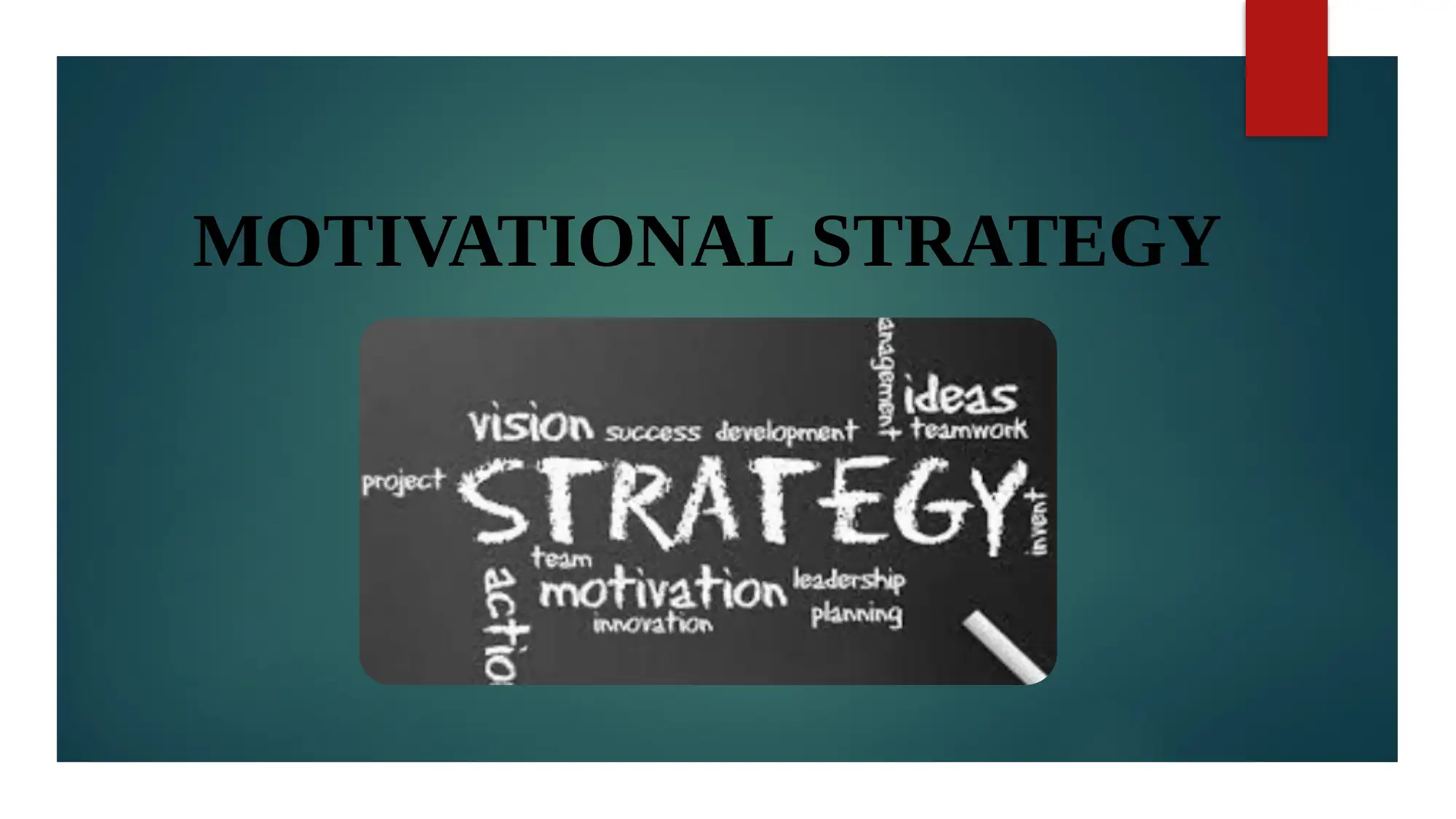
MOTIVATIONAL STRATEGY
Paraphrase This Document
Need a fresh take? Get an instant paraphrase of this document with our AI Paraphraser
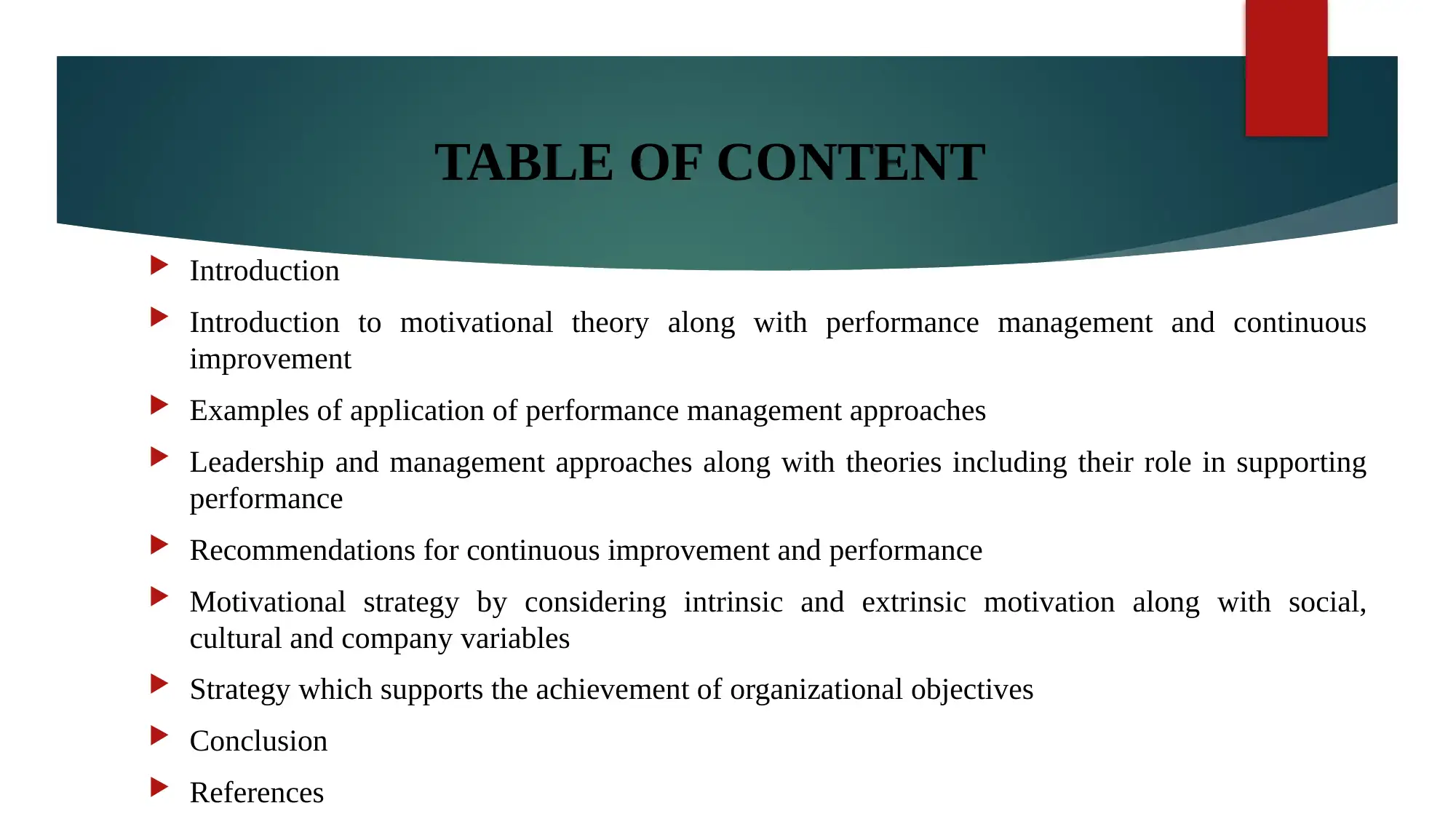
TABLE OF CONTENT
Introduction
Introduction to motivational theory along with performance management and continuous
improvement
Examples of application of performance management approaches
Leadership and management approaches along with theories including their role in supporting
performance
Recommendations for continuous improvement and performance
Motivational strategy by considering intrinsic and extrinsic motivation along with social,
cultural and company variables
Strategy which supports the achievement of organizational objectives
Conclusion
References
Introduction
Introduction to motivational theory along with performance management and continuous
improvement
Examples of application of performance management approaches
Leadership and management approaches along with theories including their role in supporting
performance
Recommendations for continuous improvement and performance
Motivational strategy by considering intrinsic and extrinsic motivation along with social,
cultural and company variables
Strategy which supports the achievement of organizational objectives
Conclusion
References
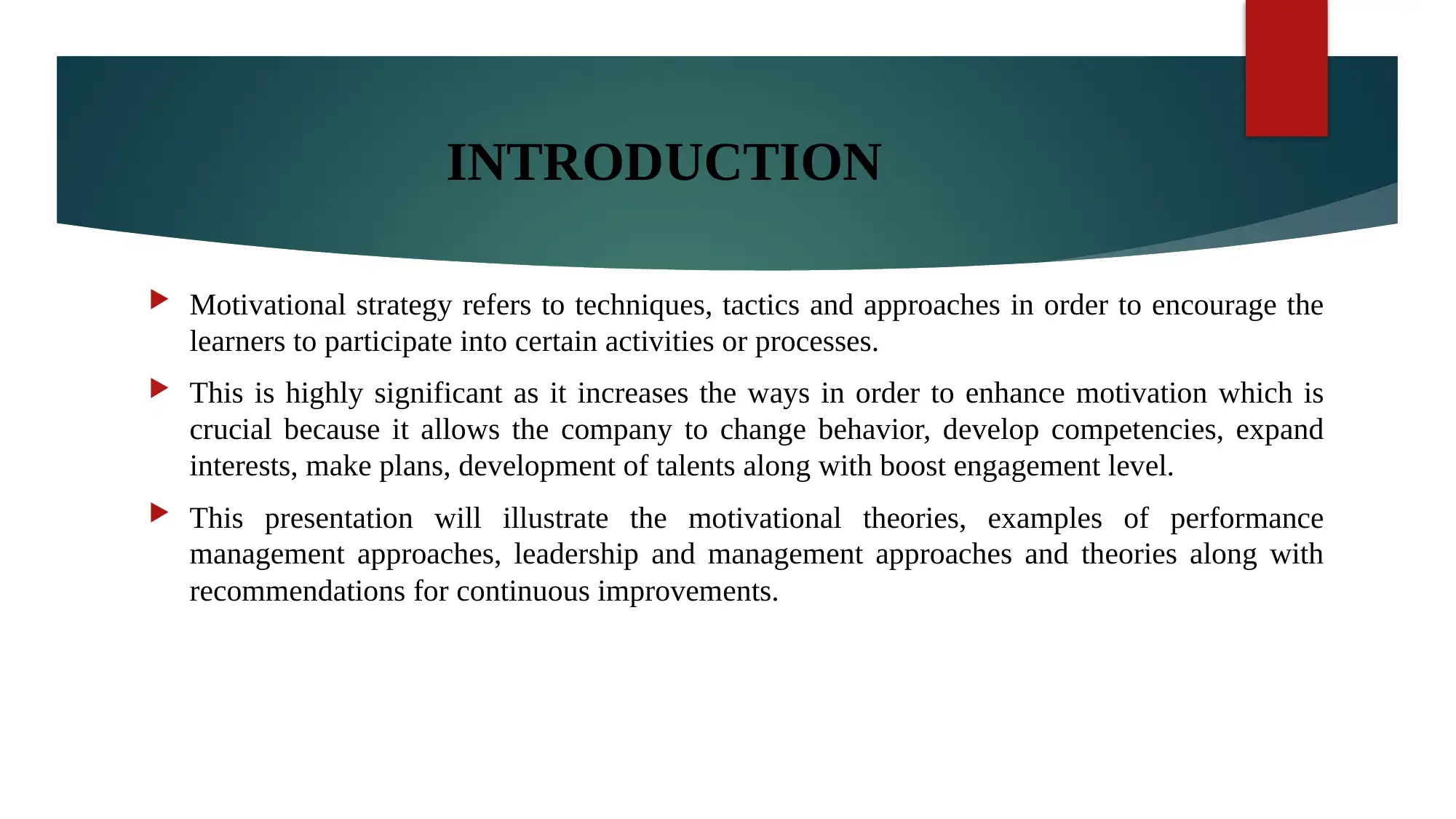
INTRODUCTION
Motivational strategy refers to techniques, tactics and approaches in order to encourage the
learners to participate into certain activities or processes.
This is highly significant as it increases the ways in order to enhance motivation which is
crucial because it allows the company to change behavior, develop competencies, expand
interests, make plans, development of talents along with boost engagement level.
This presentation will illustrate the motivational theories, examples of performance
management approaches, leadership and management approaches and theories along with
recommendations for continuous improvements.
Motivational strategy refers to techniques, tactics and approaches in order to encourage the
learners to participate into certain activities or processes.
This is highly significant as it increases the ways in order to enhance motivation which is
crucial because it allows the company to change behavior, develop competencies, expand
interests, make plans, development of talents along with boost engagement level.
This presentation will illustrate the motivational theories, examples of performance
management approaches, leadership and management approaches and theories along with
recommendations for continuous improvements.
⊘ This is a preview!⊘
Do you want full access?
Subscribe today to unlock all pages.

Trusted by 1+ million students worldwide
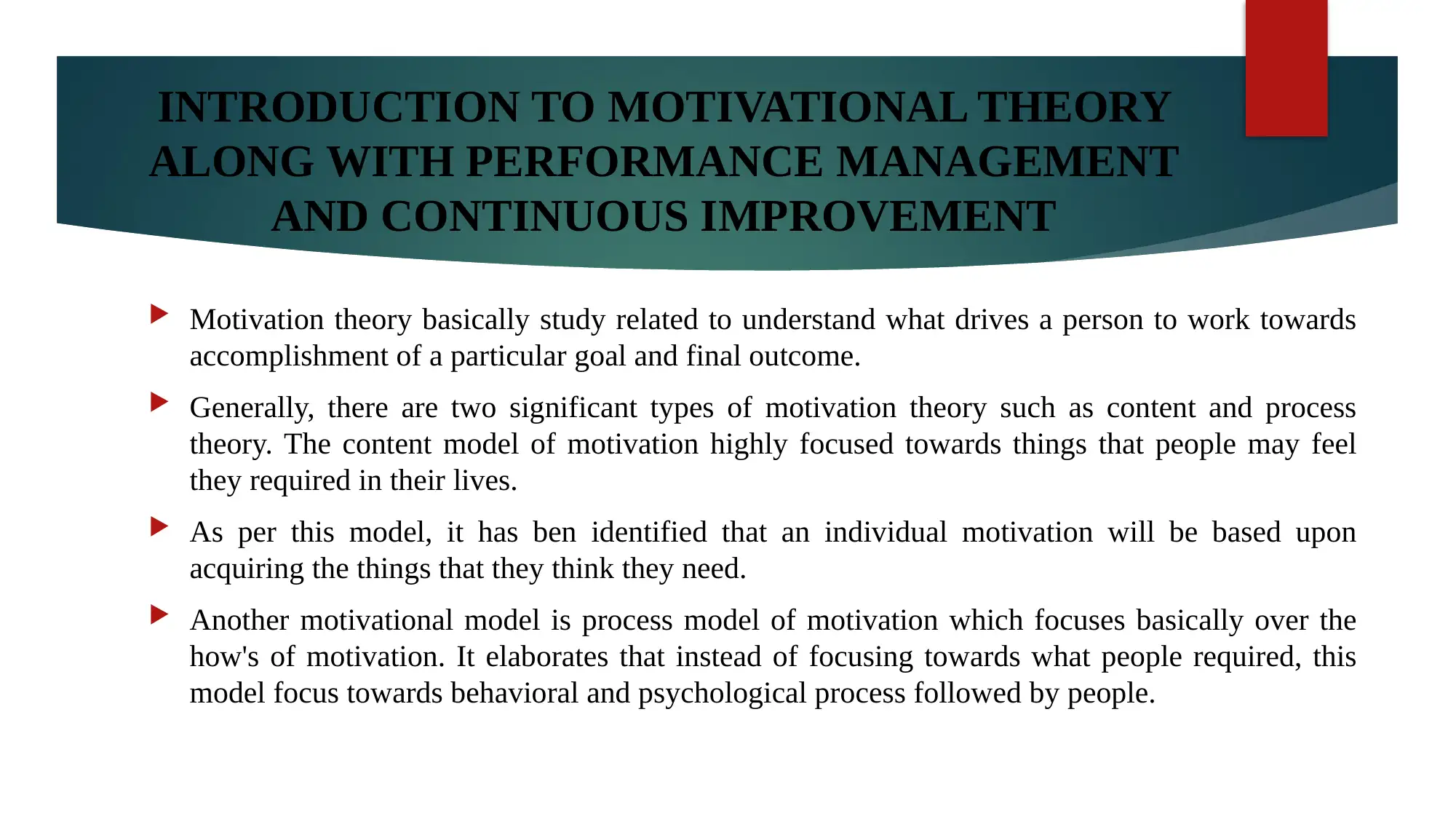
INTRODUCTION TO MOTIVATIONAL THEORY
ALONG WITH PERFORMANCE MANAGEMENT
AND CONTINUOUS IMPROVEMENT
Motivation theory basically study related to understand what drives a person to work towards
accomplishment of a particular goal and final outcome.
Generally, there are two significant types of motivation theory such as content and process
theory. The content model of motivation highly focused towards things that people may feel
they required in their lives.
As per this model, it has ben identified that an individual motivation will be based upon
acquiring the things that they think they need.
Another motivational model is process model of motivation which focuses basically over the
how's of motivation. It elaborates that instead of focusing towards what people required, this
model focus towards behavioral and psychological process followed by people.
ALONG WITH PERFORMANCE MANAGEMENT
AND CONTINUOUS IMPROVEMENT
Motivation theory basically study related to understand what drives a person to work towards
accomplishment of a particular goal and final outcome.
Generally, there are two significant types of motivation theory such as content and process
theory. The content model of motivation highly focused towards things that people may feel
they required in their lives.
As per this model, it has ben identified that an individual motivation will be based upon
acquiring the things that they think they need.
Another motivational model is process model of motivation which focuses basically over the
how's of motivation. It elaborates that instead of focusing towards what people required, this
model focus towards behavioral and psychological process followed by people.
Paraphrase This Document
Need a fresh take? Get an instant paraphrase of this document with our AI Paraphraser
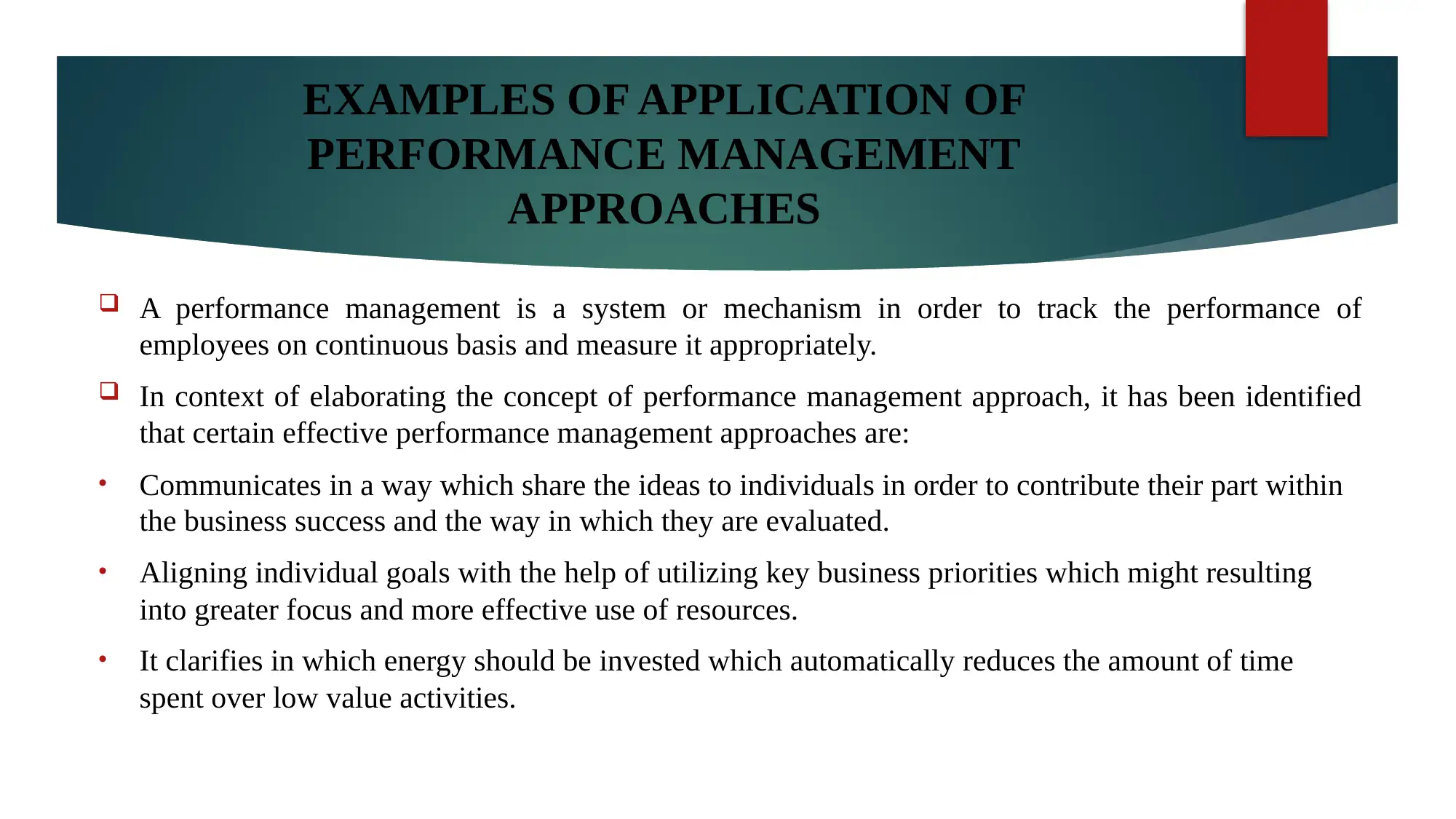
EXAMPLES OF APPLICATION OF
PERFORMANCE MANAGEMENT
APPROACHES
A performance management is a system or mechanism in order to track the performance of
employees on continuous basis and measure it appropriately.
In context of elaborating the concept of performance management approach, it has been identified
that certain effective performance management approaches are:
• Communicates in a way which share the ideas to individuals in order to contribute their part within
the business success and the way in which they are evaluated.
• Aligning individual goals with the help of utilizing key business priorities which might resulting
into greater focus and more effective use of resources.
• It clarifies in which energy should be invested which automatically reduces the amount of time
spent over low value activities.
PERFORMANCE MANAGEMENT
APPROACHES
A performance management is a system or mechanism in order to track the performance of
employees on continuous basis and measure it appropriately.
In context of elaborating the concept of performance management approach, it has been identified
that certain effective performance management approaches are:
• Communicates in a way which share the ideas to individuals in order to contribute their part within
the business success and the way in which they are evaluated.
• Aligning individual goals with the help of utilizing key business priorities which might resulting
into greater focus and more effective use of resources.
• It clarifies in which energy should be invested which automatically reduces the amount of time
spent over low value activities.
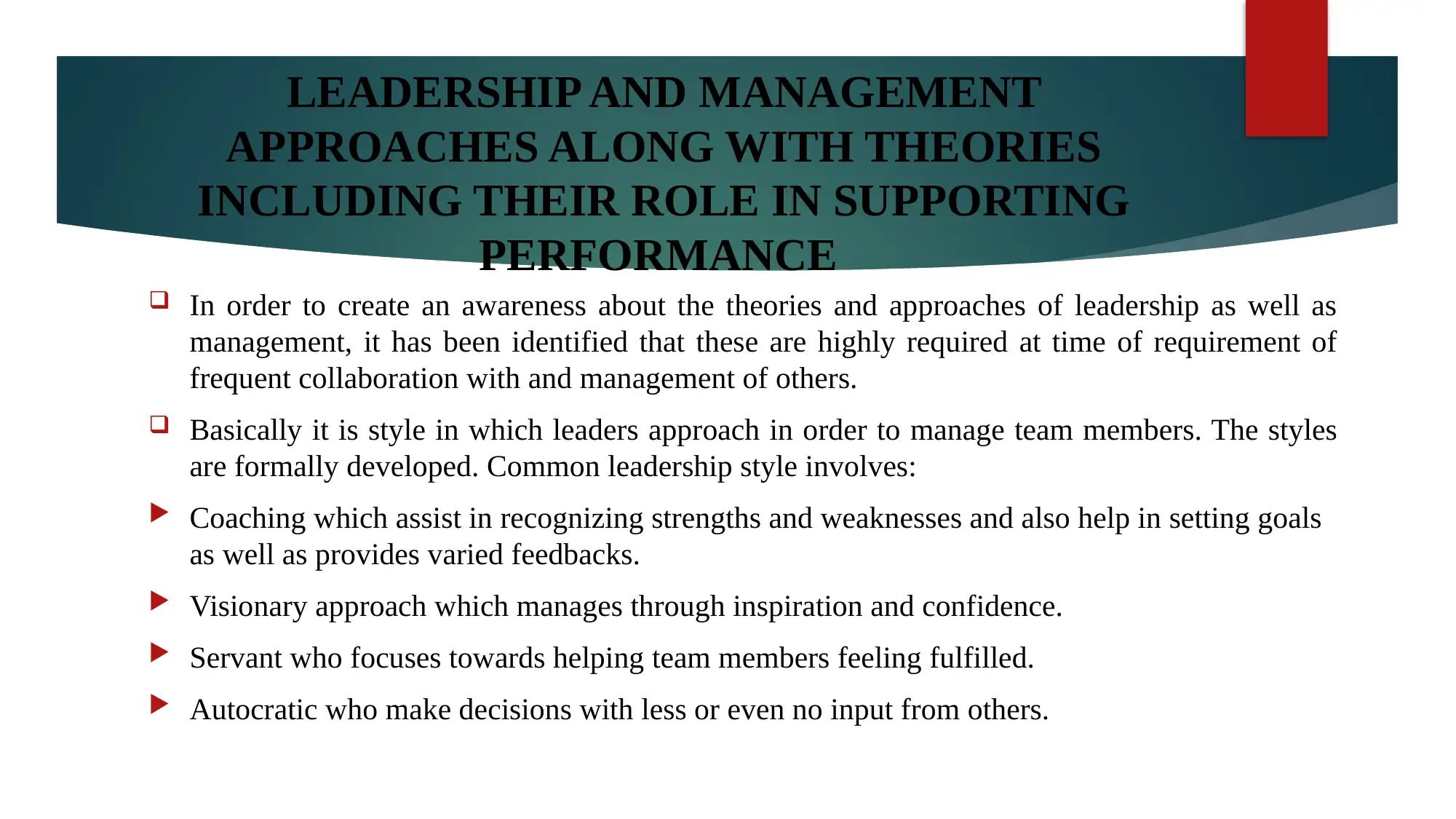
LEADERSHIP AND MANAGEMENT
APPROACHES ALONG WITH THEORIES
INCLUDING THEIR ROLE IN SUPPORTING
PERFORMANCE
In order to create an awareness about the theories and approaches of leadership as well as
management, it has been identified that these are highly required at time of requirement of
frequent collaboration with and management of others.
Basically it is style in which leaders approach in order to manage team members. The styles
are formally developed. Common leadership style involves:
Coaching which assist in recognizing strengths and weaknesses and also help in setting goals
as well as provides varied feedbacks.
Visionary approach which manages through inspiration and confidence.
Servant who focuses towards helping team members feeling fulfilled.
Autocratic who make decisions with less or even no input from others.
APPROACHES ALONG WITH THEORIES
INCLUDING THEIR ROLE IN SUPPORTING
PERFORMANCE
In order to create an awareness about the theories and approaches of leadership as well as
management, it has been identified that these are highly required at time of requirement of
frequent collaboration with and management of others.
Basically it is style in which leaders approach in order to manage team members. The styles
are formally developed. Common leadership style involves:
Coaching which assist in recognizing strengths and weaknesses and also help in setting goals
as well as provides varied feedbacks.
Visionary approach which manages through inspiration and confidence.
Servant who focuses towards helping team members feeling fulfilled.
Autocratic who make decisions with less or even no input from others.
⊘ This is a preview!⊘
Do you want full access?
Subscribe today to unlock all pages.

Trusted by 1+ million students worldwide
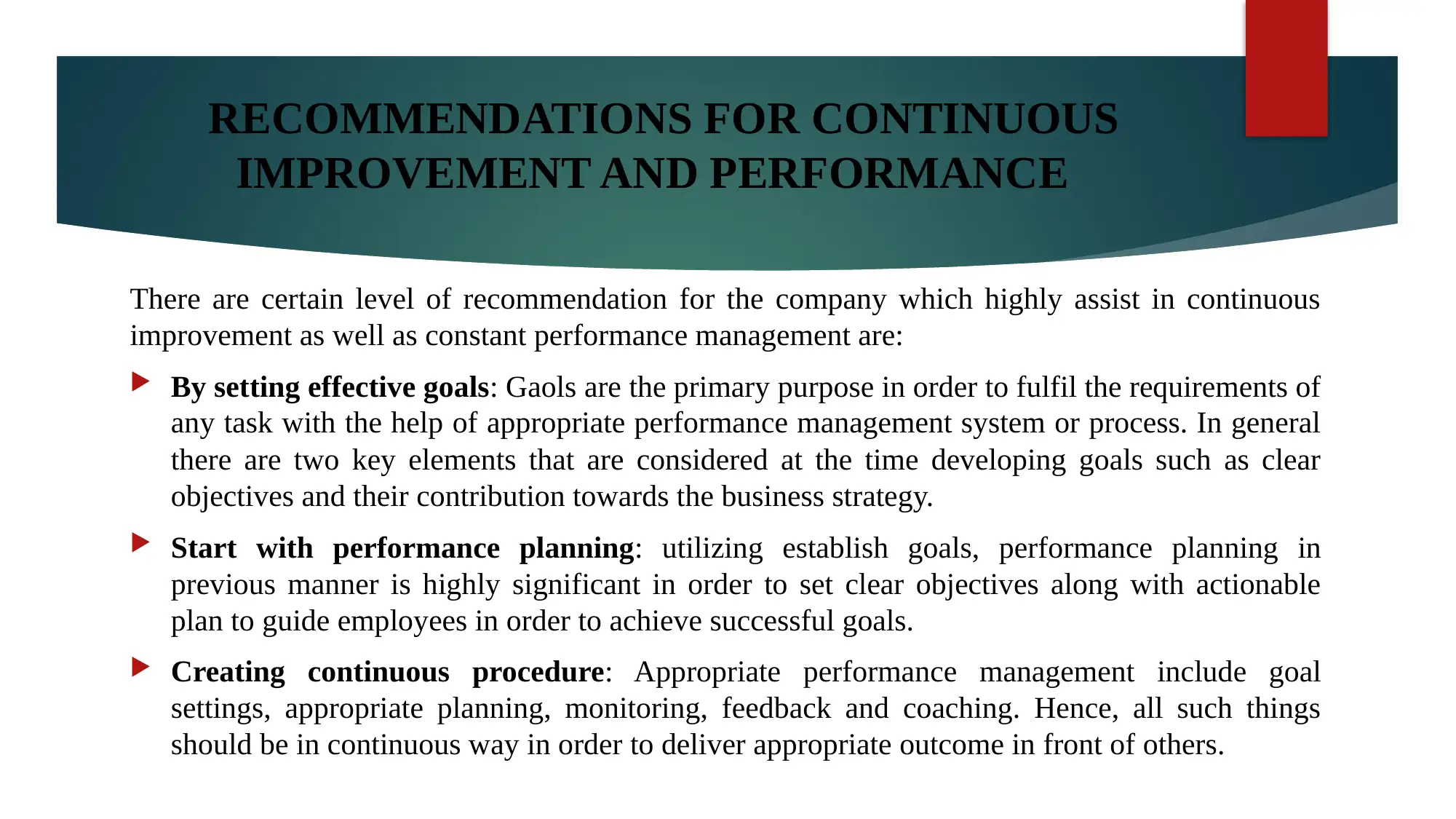
RECOMMENDATIONS FOR CONTINUOUS
IMPROVEMENT AND PERFORMANCE
There are certain level of recommendation for the company which highly assist in continuous
improvement as well as constant performance management are:
By setting effective goals: Gaols are the primary purpose in order to fulfil the requirements of
any task with the help of appropriate performance management system or process. In general
there are two key elements that are considered at the time developing goals such as clear
objectives and their contribution towards the business strategy.
Start with performance planning: utilizing establish goals, performance planning in
previous manner is highly significant in order to set clear objectives along with actionable
plan to guide employees in order to achieve successful goals.
Creating continuous procedure: Appropriate performance management include goal
settings, appropriate planning, monitoring, feedback and coaching. Hence, all such things
should be in continuous way in order to deliver appropriate outcome in front of others.
IMPROVEMENT AND PERFORMANCE
There are certain level of recommendation for the company which highly assist in continuous
improvement as well as constant performance management are:
By setting effective goals: Gaols are the primary purpose in order to fulfil the requirements of
any task with the help of appropriate performance management system or process. In general
there are two key elements that are considered at the time developing goals such as clear
objectives and their contribution towards the business strategy.
Start with performance planning: utilizing establish goals, performance planning in
previous manner is highly significant in order to set clear objectives along with actionable
plan to guide employees in order to achieve successful goals.
Creating continuous procedure: Appropriate performance management include goal
settings, appropriate planning, monitoring, feedback and coaching. Hence, all such things
should be in continuous way in order to deliver appropriate outcome in front of others.
Paraphrase This Document
Need a fresh take? Get an instant paraphrase of this document with our AI Paraphraser

MOTIVATIONAL STRATEGY BY CONSIDERING
INTRINSIC AND EXTRINSIC MOTIVATION
ALONG WITH SOCIAL, CULTURAL AND
COMPANY VARIABLES
Motivation is an important activity at the workplace. It is because of the fact that it lead
towards actions and among the key elements of the performances.
It is an individual aspect and one motivator will not necessarily motivate others.
As per the views of Elashhab, (2020) it has been evaluated that when a manager adds on
workplace components such as job designing and work environment as well as company
components such as company culture and office premises politics make everything more
challenging to understand the way in which one can motivate an employee in order to produce
effectual behavior.
For individuals, there are intrinsic and extrinsic motivating factors. Intrinsic motivation comes
from within and it is generally driven by individuals need to do something for themselves.
Each and every person has their own desires which they want to learn such as any language or
skill in order to reach a specific goal.
INTRINSIC AND EXTRINSIC MOTIVATION
ALONG WITH SOCIAL, CULTURAL AND
COMPANY VARIABLES
Motivation is an important activity at the workplace. It is because of the fact that it lead
towards actions and among the key elements of the performances.
It is an individual aspect and one motivator will not necessarily motivate others.
As per the views of Elashhab, (2020) it has been evaluated that when a manager adds on
workplace components such as job designing and work environment as well as company
components such as company culture and office premises politics make everything more
challenging to understand the way in which one can motivate an employee in order to produce
effectual behavior.
For individuals, there are intrinsic and extrinsic motivating factors. Intrinsic motivation comes
from within and it is generally driven by individuals need to do something for themselves.
Each and every person has their own desires which they want to learn such as any language or
skill in order to reach a specific goal.
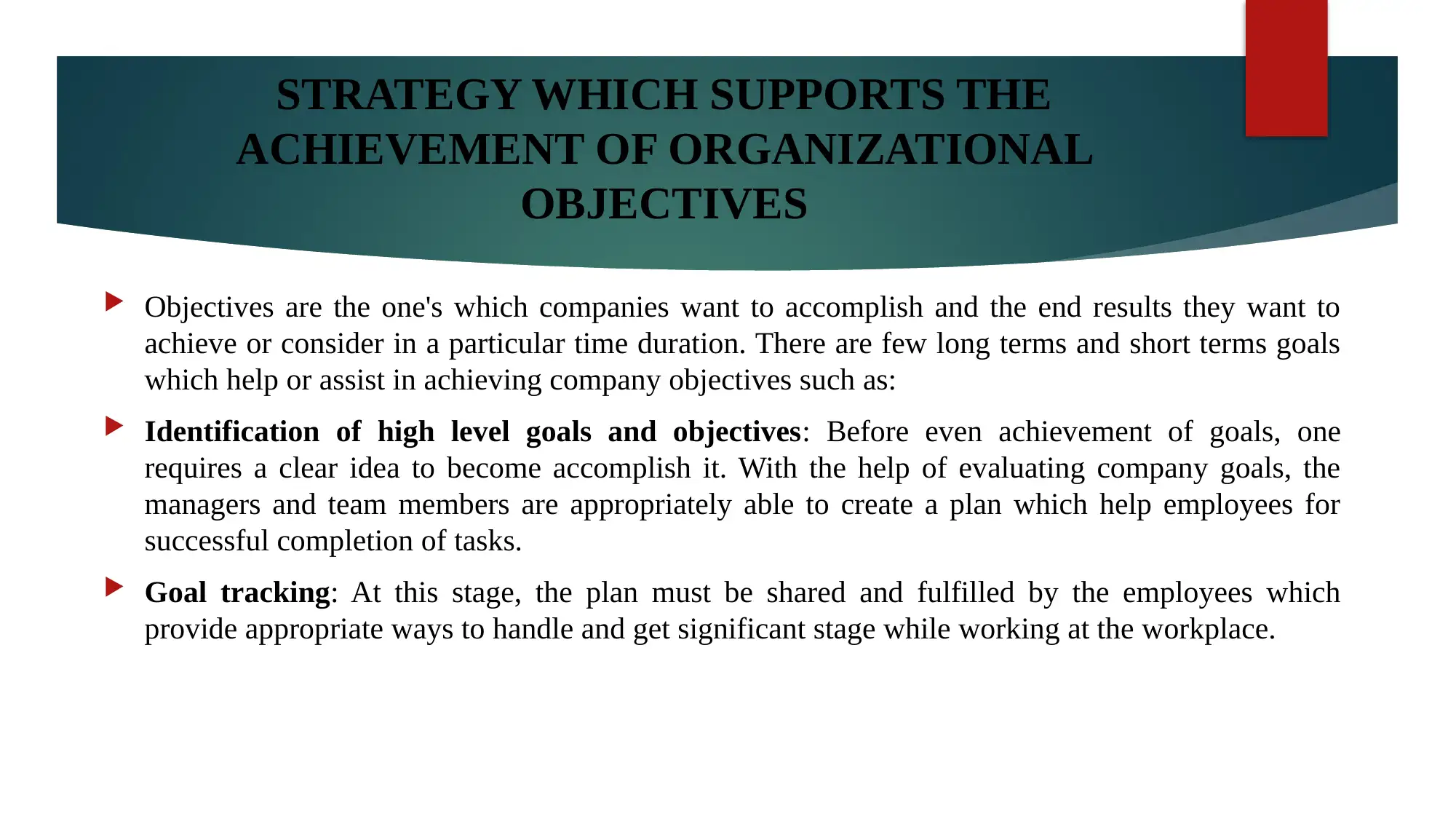
STRATEGY WHICH SUPPORTS THE
ACHIEVEMENT OF ORGANIZATIONAL
OBJECTIVES
Objectives are the one's which companies want to accomplish and the end results they want to
achieve or consider in a particular time duration. There are few long terms and short terms goals
which help or assist in achieving company objectives such as:
Identification of high level goals and objectives: Before even achievement of goals, one
requires a clear idea to become accomplish it. With the help of evaluating company goals, the
managers and team members are appropriately able to create a plan which help employees for
successful completion of tasks.
Goal tracking: At this stage, the plan must be shared and fulfilled by the employees which
provide appropriate ways to handle and get significant stage while working at the workplace.
ACHIEVEMENT OF ORGANIZATIONAL
OBJECTIVES
Objectives are the one's which companies want to accomplish and the end results they want to
achieve or consider in a particular time duration. There are few long terms and short terms goals
which help or assist in achieving company objectives such as:
Identification of high level goals and objectives: Before even achievement of goals, one
requires a clear idea to become accomplish it. With the help of evaluating company goals, the
managers and team members are appropriately able to create a plan which help employees for
successful completion of tasks.
Goal tracking: At this stage, the plan must be shared and fulfilled by the employees which
provide appropriate ways to handle and get significant stage while working at the workplace.
⊘ This is a preview!⊘
Do you want full access?
Subscribe today to unlock all pages.

Trusted by 1+ million students worldwide
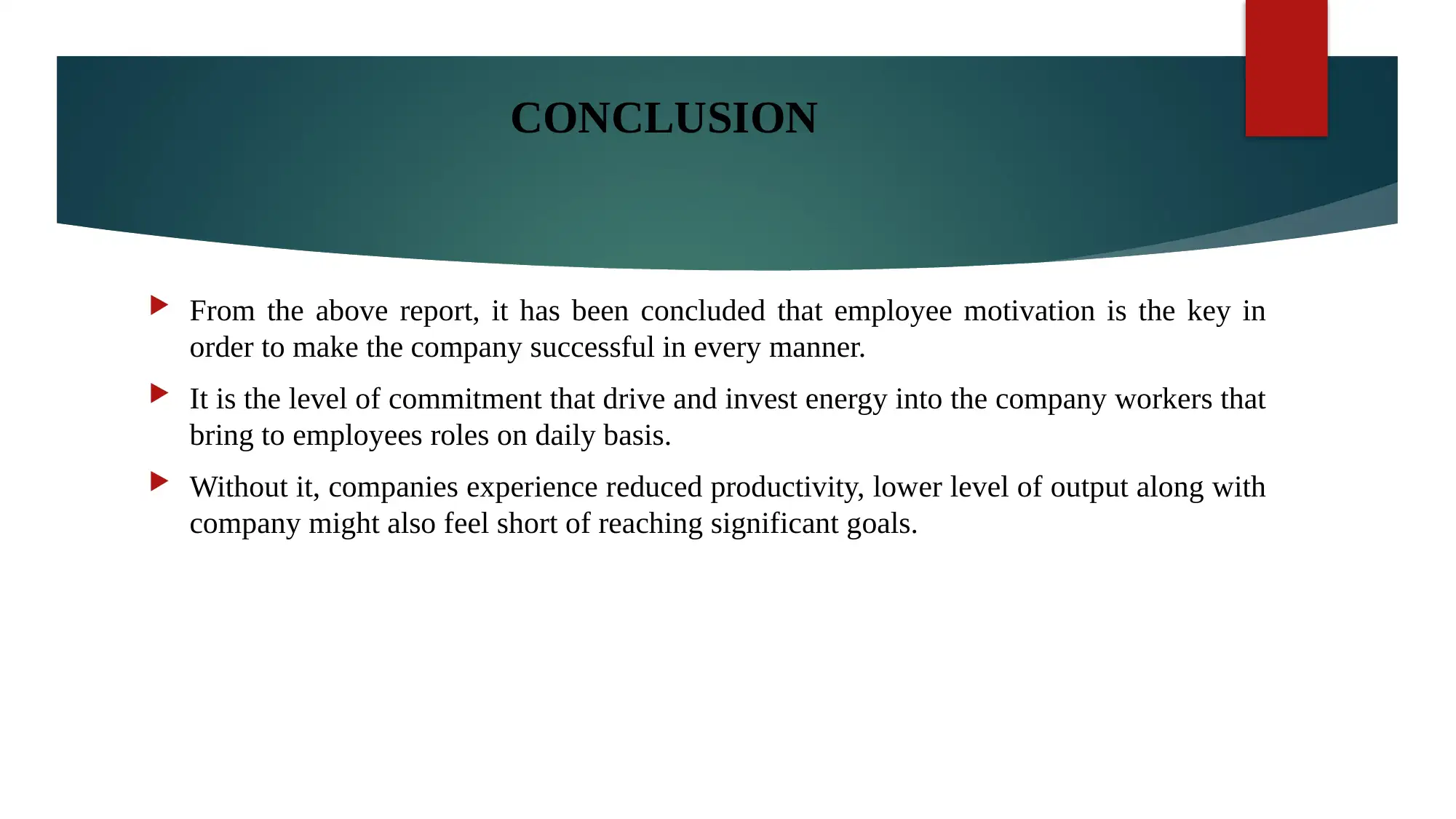
CONCLUSION
From the above report, it has been concluded that employee motivation is the key in
order to make the company successful in every manner.
It is the level of commitment that drive and invest energy into the company workers that
bring to employees roles on daily basis.
Without it, companies experience reduced productivity, lower level of output along with
company might also feel short of reaching significant goals.
From the above report, it has been concluded that employee motivation is the key in
order to make the company successful in every manner.
It is the level of commitment that drive and invest energy into the company workers that
bring to employees roles on daily basis.
Without it, companies experience reduced productivity, lower level of output along with
company might also feel short of reaching significant goals.
Paraphrase This Document
Need a fresh take? Get an instant paraphrase of this document with our AI Paraphraser
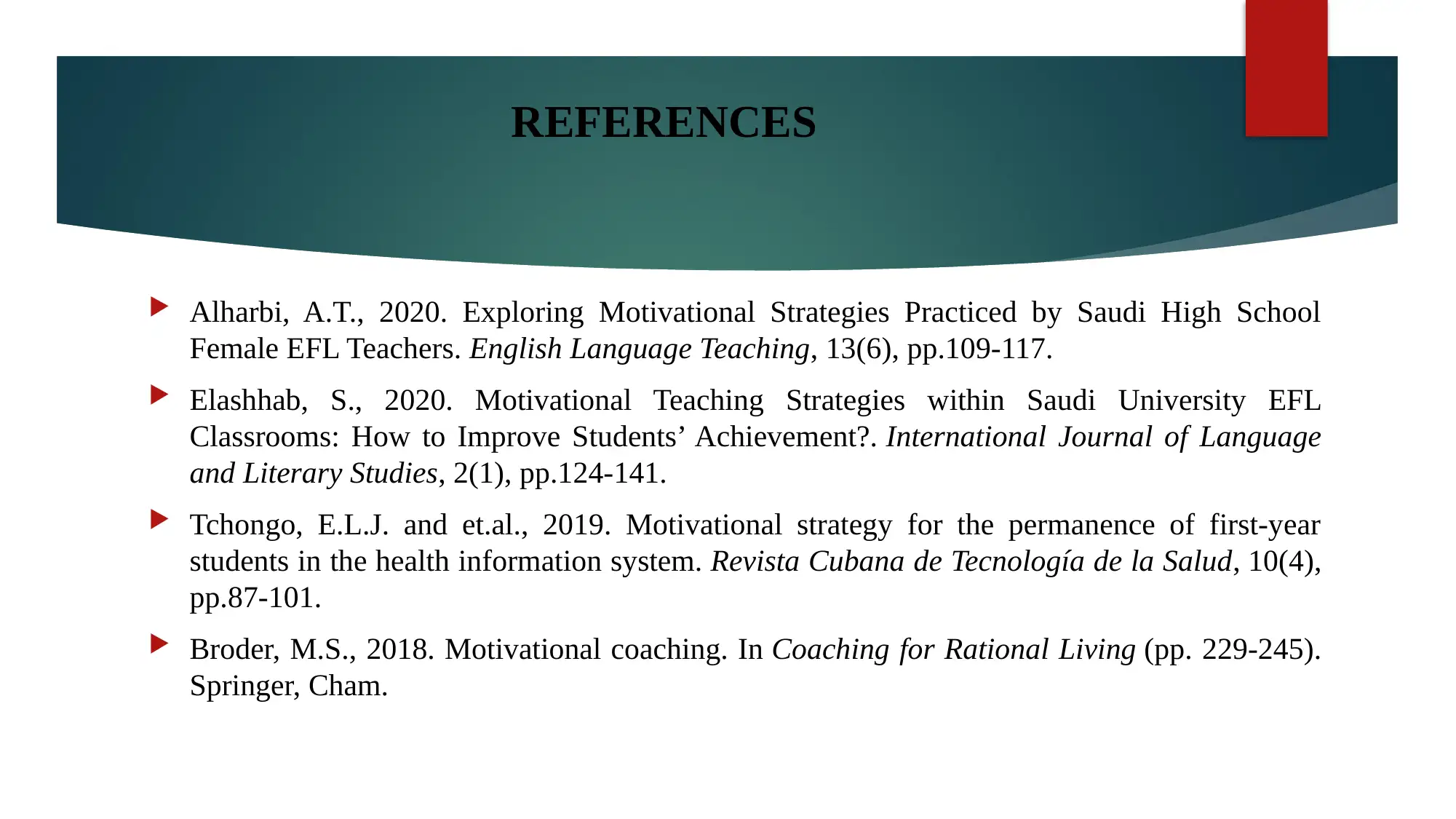
REFERENCES
Alharbi, A.T., 2020. Exploring Motivational Strategies Practiced by Saudi High School
Female EFL Teachers. English Language Teaching, 13(6), pp.109-117.
Elashhab, S., 2020. Motivational Teaching Strategies within Saudi University EFL
Classrooms: How to Improve Students’ Achievement?. International Journal of Language
and Literary Studies, 2(1), pp.124-141.
Tchongo, E.L.J. and et.al., 2019. Motivational strategy for the permanence of first-year
students in the health information system. Revista Cubana de Tecnología de la Salud, 10(4),
pp.87-101.
Broder, M.S., 2018. Motivational coaching. In Coaching for Rational Living (pp. 229-245).
Springer, Cham.
Alharbi, A.T., 2020. Exploring Motivational Strategies Practiced by Saudi High School
Female EFL Teachers. English Language Teaching, 13(6), pp.109-117.
Elashhab, S., 2020. Motivational Teaching Strategies within Saudi University EFL
Classrooms: How to Improve Students’ Achievement?. International Journal of Language
and Literary Studies, 2(1), pp.124-141.
Tchongo, E.L.J. and et.al., 2019. Motivational strategy for the permanence of first-year
students in the health information system. Revista Cubana de Tecnología de la Salud, 10(4),
pp.87-101.
Broder, M.S., 2018. Motivational coaching. In Coaching for Rational Living (pp. 229-245).
Springer, Cham.

⊘ This is a preview!⊘
Do you want full access?
Subscribe today to unlock all pages.

Trusted by 1+ million students worldwide
1 out of 12
Related Documents
Your All-in-One AI-Powered Toolkit for Academic Success.
+13062052269
info@desklib.com
Available 24*7 on WhatsApp / Email
![[object Object]](/_next/static/media/star-bottom.7253800d.svg)
Unlock your academic potential
Copyright © 2020–2025 A2Z Services. All Rights Reserved. Developed and managed by ZUCOL.




